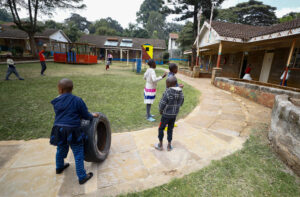
LOS ANGELES (BP)–Most Christians understand the threat posed by militant Islam around the world, but few are aware of a strain of Hindu radicalism targeting believers in India.
George Ninan, a South Asia director for Campus Crusade for Christ, told ASSIST News Service, “There is a well-rehearsed plan for violence against churches and evangelists” in the sprawling sub-continent inhabited by one-sixth of the world’s population.
Ninan, on staff with Crusade since 1971, said in a Feb. 11 ASSIST report, “One month ago two of our staff members were beaten up while they were talking to students at the university. They were taken to the police station and the police did the same thing.”
“These are things that wouldn’t have happened a few years back,” Ninan said.
In recent years, militant groups have arisen that trumpet a Hindu “race” and culture, urging that Hinduism be recognized as the official state religion. One such group, the National Volunteer Service (RSS), is influenced by 1930s-style Nazism, Ninan said, noting that such groups are gaining influence in high places.
“These groups have been in existence in different names in the last 60 to 100 years,” Ninan said. “It was people who believed in this ideology who killed Mahatma Gandhi,” he said. “Now we have a new political party that subscribes to the same views.
“I may be wrong, but there is a feeling that the ones who are in power would support this,” Ninan said, referring to the persecution. “The members of radical groups feel they can do these things and get away with it.”
In 1997, a Jesuit priest from Belgium named Father Thomas was killed by Hindu nationalists disguised as police officers. The same year, another priest was severely beaten and paraded naked through the streets by militants — all within view of the police, according to Freedom House in Washington D.C.
Two years later, an Australian missionary and his two sons were burned to death in their van by Hindu extremists. More than 100 incidents of violence have been documented against Christians since 1998, including the rape of four nuns and one nun shot in the face. Many Christians were injured, killed or left homeless by such attacks.
“When they attacked a Catholic institution and raped the nuns,” Ninan said, even some news reports stated that the nuns were raped because they were converting people. “Instead of condemning it, they said, ‘Maybe there’s a reason to justify it,'” Ninan said.
“Even when the Australian missionary and his two children were burned, India’s home minister said, ‘Now I’m certain none of our Hindu activists were involved,'” Ninan continued. “But how does he know,” Ninan asked, “even before preliminary investigations were over?
“All these things lead us to a state where we can’t believe in the system,” Ninan said. “We can’t trust them, but we can’t prove anything against them.”
In addition to religious persecution, Indian society is beset by other deeply rooted social problems. The New York Times reported that one-third of the elected officials in India’s most populous state have criminal backgrounds. India’s judicial system has a logjam of 30 million unheard cases, and the system is considered off-limits to the poor.
The army and police have been accused of torture and arbitrary disappearances, particularly against low-caste members of society. Female convicts are often raped while in custody, according to Freedom House.
Every year, disputes over the outlawed dowry practice cause several thousand women to be burned to death, driven to suicide or killed, while authorities take little action, India observers report. Some of India’s major cities have thousands of street children, and millions of under-age workers exist in forced servitude in industrial and agricultural settings, Freedom House reports.
Such entrenched social problems may lead some to lash out at any kind of scapegoat — including Christians. “There is a hatred and a division being created that goes really deep,” Ninan said. “First they go after the people who are involved in evangelism and discipleship,” he said. “They say, ‘You’re going against our culture; you are destroying our traditions. And they get people on their side.
“If practicing faith means going to church or prayer meetings and wearing a cross, I can do that and nobody objects to that,” Ninan said. “But if you believe in witnessing for your faith and seeing people coming to Christ, there is always a danger that somebody will come after you.”
Many Christians had their hopes raised for revival by an unprecedented rally of about 1 million of India’s “untouchables,” known as Dalits, last November. At the rally, the Dalits announced they were leaving Hinduism en masse for another religion. Dalit leaders agreed to consider the case for Jesus Christ, as well as other major religions.
The word Dalit means “oppressed” or “broken to pieces,” and under Hindu rules, these poorest of the poor are not even allowed to enter all Hindu temples. It is considered socially unacceptable to allow a Dalit to even attend a religious festival.
Some thought if the Dalits responded to Christianity, it could be one of the greatest revivals of all time. Some estimate there are 200 million to 250 million Dalits trapped in India’s caste system — their fates considered to be determined at birth.
When Dalit leaders ultimately embraced Buddhism, many Christians were deeply disappointed. “Only very few Dalits heard about this movement,” Ninan recounted. “The propaganda was that 10 million would show up in Dehli for the rally and that 350 million would become Christians that day, but that didn’t happen because of their fears of losing certain rights if they converted to Christianity.”
Under India’s legal system, if the Dalits converted to Christianity, they would lose their eligibility for affirmative action programs. But if they converted to Buddhism, considered to be an offshoot of Hinduism, they would still maintain their benefits.
Ninan said he believes false expectations were raised by the rally and mass conversion last year. “It was a social movement,” he said. “It was not a spiritual movement at all. It was people getting out of Hinduism for their convenience — this is not the type of Christian we want at all.” Further, one so-called Dalit leader quoted in the press did not carry the influence attributed to him, Ninan added.
“Every day there are Dalits who come to Christ and join the church,” he noted. “If they join the church they lose their privileges — and everybody knows that.”
Ninan oversees 1,250 teams showing the “Jesus” film in different parts of India, with most working in partnership with local churches. “In the last two years 1,200 churches have been established by our partners,” he said.
While Ninan hasn’t seen the revival he prays for daily, he remains hopeful about India, despite its unusual obstacles to the Christian faith. “Most of the ministries are seeing results,” he said. “We might not make a lot of noise, but the church is growing, and I’m excited about that.”
–30–
Ellis is a senior correspondent for ASSIST News Service. Used by permission.















